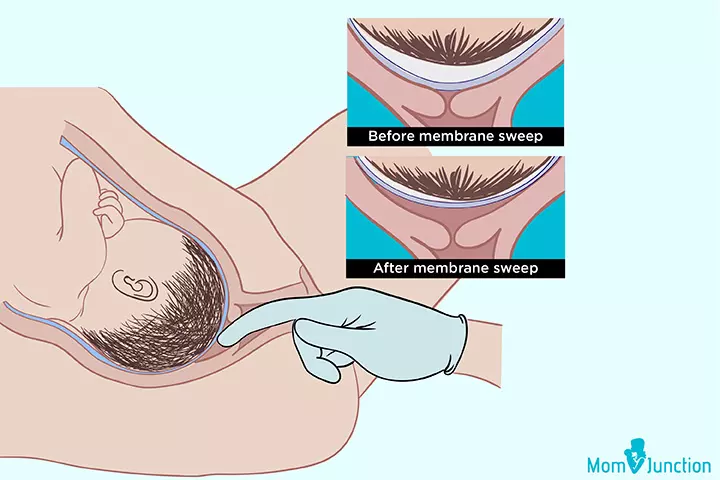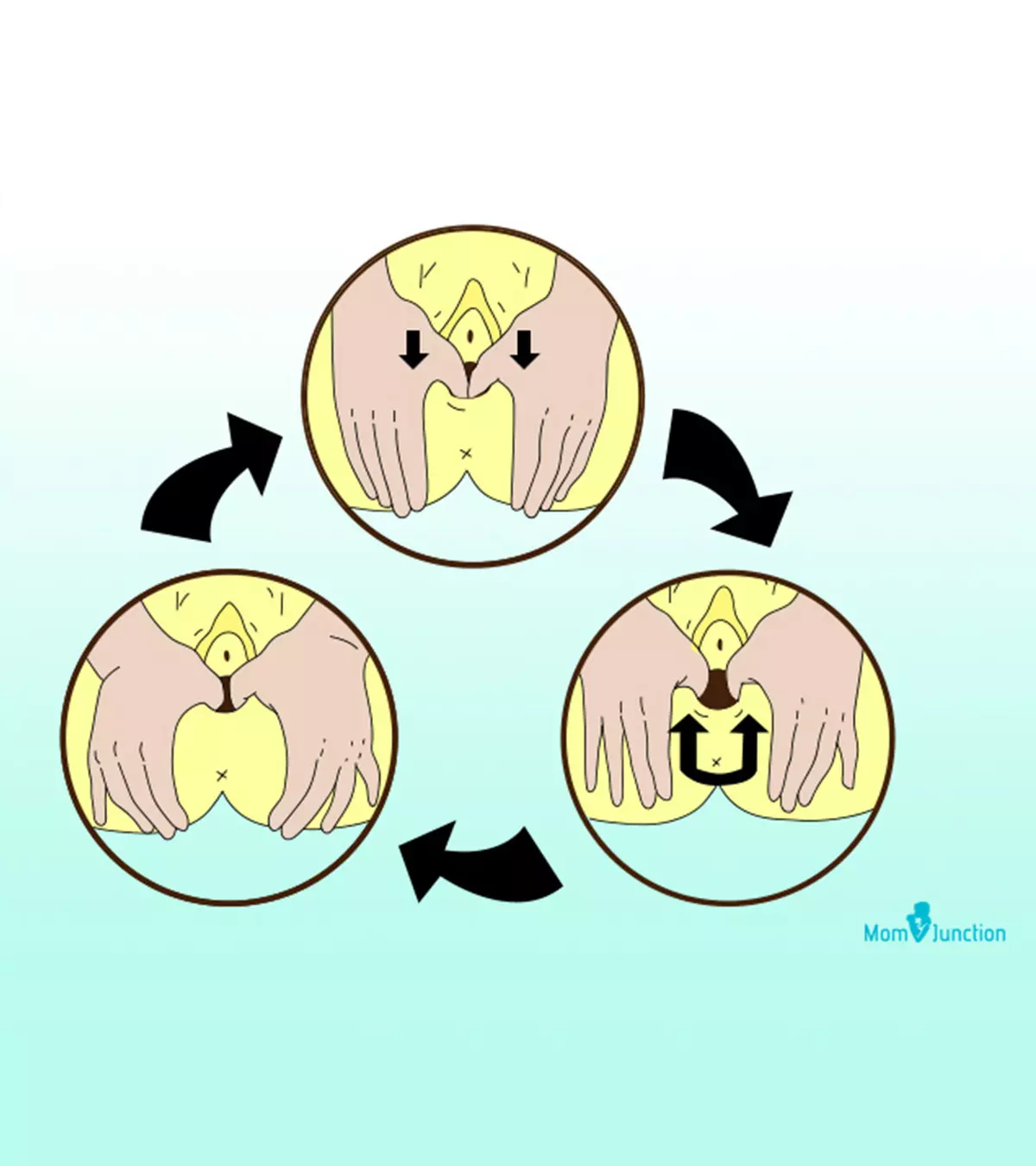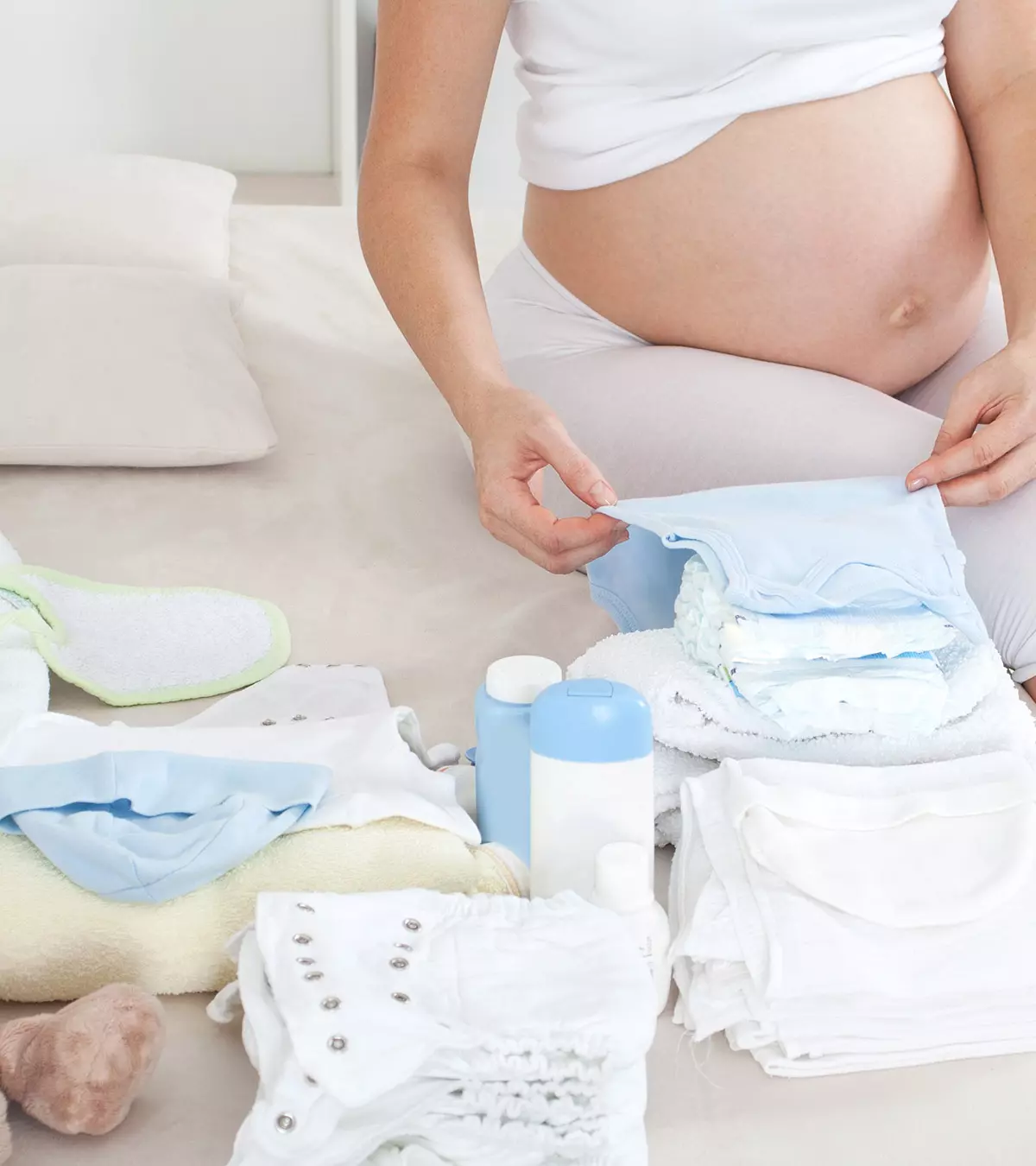
A healthcare provider does a membrane sweep with a gloved finger during labor. They may sweep the membrane that connects the amniotic saciThe water or fluid-filled sac within the womb necessary for the growth and development of the fetus. to wall it off from the uterus after the cervix is dilated. This is also called stripping the membranes or sweeping the membranes and may speed up the labor process. It is not possible to do this maneuver when the cervix is closed. Read on to know more about the membrane sweep, when it is done, and how it speeds up the labor process.
Key Pointers
- The membrane sweep is a common practice for women who opt for vaginal birth.
- Healthcare workers perform the procedure by separating the amniotic sac from the uterine wall and cervix using their fingers.
- It is typically done during the 40-41st week of pregnancy to facilitate labor.
- Women experiencing membrane rupture, low-lying placenta, cervical closure, or other medical conditions should not undergo the procedure.
- If there is blood loss or intense discomfort after the procedure, it is highly recommended to seek a doctor’s consultation.
What Is A Membrane Sweep?

Membrane sweeping, also known as cervical sweeping or membrane stripping, manually stimulates the cervix to release the hormone called prostaglandins to promote the onset of natural labor (1).
It could be a useful method but might also bring discomfort, irregular contractions, and some bleeding. This technique may also reduce the need for other medical interventions such as prostaglandinsiA group of compounds used to promote uterine contractions due to its hormone-like effects and oxytocinsiA hormone secreted by the pituitary gland to stimulate contractions during childbirth and lactation. for inducing labor or even a C-section for delivering the child (2).
Doctors or midwives may recommend this procedure, but only under certain circumstances.
Is Membrane Sweeping Safe?
Membrane sweeping is generally safe and often effective in triggering labor naturally (3). While there may be some discomfort, it is a viable initial labor induction option. Some research studies show that membrane sweeping increases the likelihood of spontaneous labor onset by approximately 21%, concurrently reducing the need for induction by 27% (4). If your due date is approaching, talking with your healthcare provider about the potential benefits and risks associated with membrane sweeping is prudent.
When Is A Membrane Sweep Done?
A membrane sweep is offered if the pregnancy is prolonged.
- If you are a first-time mom, it might be done during the 40th week of pregnancy. Sharing her experience, a mother and blogger, Mel writes, “At my 37 week check up, I was about 3 cm dilated according to my OB… at my 40-week appointment (the day before my due date), I was 3-4cm dilated. The NP said I was almost 4cm dilated and she could probably stretch me to 4cm with a membrane sweep. We agreed to do that, and to my surprise, it was relatively painless (unlike the membrane sweep I had with Zain). Over the weekend, I didn’t notice any significant contractions – just mild cramping here and there. “Then, on Tuesday morning around 6:15, I was startled awake by what felt like a punch to my uterus. I immediately wondered if my water had broke because the feeling reminded me of when my water broke with Sami (i).” Following this, Mel had a relatively quick progression of labor, and she delivered a baby girl before the arrival of paramedics.
- If you have given birth before, then it could be done at 41 weeks (5).
A membrane sweep may also be offered when someone has been in and out of a prolonged labor without the rupture of membranes (3). It could be one of the safest and non-invasive methods that may not pose any risk. Keep reading to understand how the procedure is done.
How Is It Done?

Membrane sweeping is done for women who are planning a vaginal birth. A woman’s cervix needs to be effaced by a minimum of 1-2 centimeters for the sweep to be performed by a gynecologist or professional midwife (3). The procedure is explained below (6):
- The doctor checks the estimated delivery date.
- You may be asked to empty your bladder and lie on the labor table.
- The mattress is tilted towards the left side to avoid supine hypertensioniAn drastic elevation in blood pressure after lying down for a few minutes. .
- The doctor or midwife inserts a finger into the vagina to feel the cervix and the position of the baby. They check if the cervix is favorable for carrying out this procedure.
- If yes, a gentle and circular sweep movement is done inside the cervix to separate the amniotic sac from the uterine wall and the cervix. This is likely to promote the release of prostaglandins and facilitate childbirth.
- A sign of a successful membrane sweep is the onset of labor within 48 hours and delivery within one week.
The condition of the cervix could be a determining factor for the effectiveness of this method.
- If the cervix is unfavorable or uneffaced, then this procedure may not be carried out.
- If the cervix is soft but closed, then a cervical massageiA technique used to enable initiation of cervical dilation. is offered until it allows the insertion of a finger, to increase the effectiveness of this procedure.
- If the cervix doesn’t open, massaging around the vaginal fornicesiA pocket-like area at the upper end of the vaginal canal, where the cervix protrudes into the vagina. may stimulate the release of prostaglandins. If labor pain doesn’t start even after 36 hours, then this process might be repeated.
After the procedure is done, you may have to follow certain instructions given by your doctor.
 Quick fact
Quick factWhat To Expect After The Procedure?
Once the procedure is done,
- You might notice spotting or light vaginal bleeding (7).
- You might also notice cramping and irregular contractions (3).
- You may have to wear a sanitary pad and wait for labor.
- The doctor might advise you to take a warm bath and paracetamol in case of painful contractions and discomfort.

- You should seek immediate medical attention in case of blood loss, unbearable pain, or spontaneous rupture of the membrane.
Recalling the symptoms she experienced after the membrane sweep, Dani Tippett, a mother of two and a postpartum Doula’s assistant, says, “The 38-week membrane sweep was not as effective as I was hoping it would be, but it did bring on real, painful contractions. They were just very inconsistent and unpredictable (ii).”
The procedure may have to be repeated if the labor doesn’t start within the expected time.
Although this procedure is considered ideal for inducing natural labor, it is not always recommended.
When Should You Not Get A Membrane Sweep Done?
Membrane sweep may not be carried out under the following conditions:
- Rupture of membrane
- Low lying placenta
- Closed cervix
- The baby’s head is not engaged
- When the mother is Rh-negativeiBlood type of people who do not have the protein named Rh factor in their blood cells.
- Vaginal infections
Membrane sweeping has its advantages and disadvantages. Let us see what they are.
 Point to consider
Point to considerAdvantages And Disadvantages Of Membrane Sweep
Like many other procedures, membrane sweep also has its pros and cons (8):
Advantages
- Promotes the onset of spontaneous labor.
- Requires no hospital admission as it could be done during a regular pregnancy check-up.

- Considered to be safe and efficient.
Disadvantages

- Uncomfortable and slightly painful.
- May not start labor in the first attempt itself.
- Risk of rupturing the amniotic sac.
- Vaginal bleeding, spotting, and irregular contractions might be experienced post-procedure.
This procedure is used to initiate labor naturally, owing to its success rate, albeit low.
 Quick fact
Quick factWhat Is The Success Rate Of Membrane Sweep?
According to a review published in the British Journal of Obstetrics & Gynecology, membrane sweeping was found to increase the possibility of labor within 48 hours by 24%. The chances of delivering within a week were about 46 %, and the chances of the delivery not being prolonged over two weeks were about 74% (9).
Frequently Asked Questions
1. How do I know if the membrane sweep has worked?
If membrane sweep has been effective, you are likely to experience signs of labor. These include cramping, regular and stronger uterine contractions, vaginal spotting or bleeding, loss of mucus plugiA thick, protective accumulation of mucus that accumulates in the cervical canal during pregnancy. water break, increased cervix dilation, heavy bleeding, or severe pain in about 48 hours after membrane sweep may indicate that the procedure worked (3) (10).
2. Does membrane sweep remove mucus plug?
Yes, you may lose your mucus plug if the labor starts after the membrane sweep (3). Contact your doctor immediately if you experience heavy bleeding along with losing your mucus plug, as it may indicate a complication that requires prompt care.
3. How do I know if the membrane sweep doesn’t work?
Most women experience symptoms of labor within 48 hours of the procedure. While some may take a little longer, if you do not experience any symptoms at all, even past 48 hours, it may indicate that the procedure did not work. Your Ob/Gyn will help you confirm if the procedure worked or not (3) (10).
4. What makes a membrane sweep successful?
There may be more chances of a membrane sweep being successful if you are past your due date, are already in the early stages of labor, or have a thin, soft, or dilated cervix (3).
5. How far dilated do I have to be for a membrane sweep?
You need to be dilated by about 1-2cm or at least enough for a doctor to pass their finger and perform the sweep (3).
Both membrane sweep and medical induction are used to induce labor. In a membrane sweep, your doctor will insert a finger and physically brush the membrane to induce labor. This process might be slightly painful. In medical induction, you are given medicines through injection or IV to induce delivery(6). However, membrane sweep may help you get into labor naturally, unlike induction, where medications are needed (3).
A membrane sweep can naturally induce and speed up labor, which may help ease your delivery. It is a smooth and easy process that may not cause any concern. However, because it can be a bit unpleasant and has certain risks, you should evaluate the benefits and drawbacks, as well as discuss the details and efficacy of the procedure with your doctor before deciding to go ahead with it.
Infographic: Advantages And Disadvantages Of Membrane Sweep
Membrane sweeping is a well-known procedure performed to induce labor. If you are nearing your due date and are willing to know more about this procedure, our infographic can help you learn the pros and cons to aid you in making the right decision. Illustration: Momjunction Design Team
A membrane sweep is a simple procedure to help induce labor. Learn how it works in this informative video!
Personal Experience: Sources
MomJunction articles include first-hand experiences to provide you with better insights through real-life narratives. Here are the sources of personal accounts referenced in this article.
i. Laila’s Unplanned Home Birth Story;
https://duoventures.blogspot.com/2019/08/lailas-unplanned-home-birth-story.html#more
ii. Micah’s birth story: faster isn’t always better;
https://medium.com/@daniktippett/micahs-birth-story-faster-isn-t-always-better-80b8b506d79
References
1. Boulvain M et al.; Membrane sweeping for induction of labour; Cochrane Database Syst Rev (2005)
2. MG Nyamz et al.; Effectiveness of sweeping of membranes in reducing the incidence of elective induction of labor for postdate pregnancies; Archives of Medicine and Surgery
3. Membrane Sweep; Cleveland Clinic
4. Finucane E et al.; Membrane sweeping for induction of labour; Cochrane Database Syst Rev (2020)
5. Membrane Sweep; North Bristol NHS Trust
6. Membrane sweeping and induction of labour; Maidstone and Tunbridge Wells NHS Trust
7. Sweeping of the Membranes at Term; Midwifery Led Unit – Cavan General Hospital
8. Pregnancy Beyond 41 Weeks; Expert Advisory Group of NSW Ministry of Health (2014)
9. Sweeping The Membranes; Midwifery.org, UK
10. Membrane Sweeping; Wiley Online Library
Community Experiences
Join the conversation and become a part of our nurturing community! Share your stories, experiences, and insights to connect with fellow parents.
Read full bio of Dr. Monica Agarwal
Read full bio of Sakshi Mishra
Read full bio of Rebecca Malachi
Read full bio of Dr. Joyani Das



















